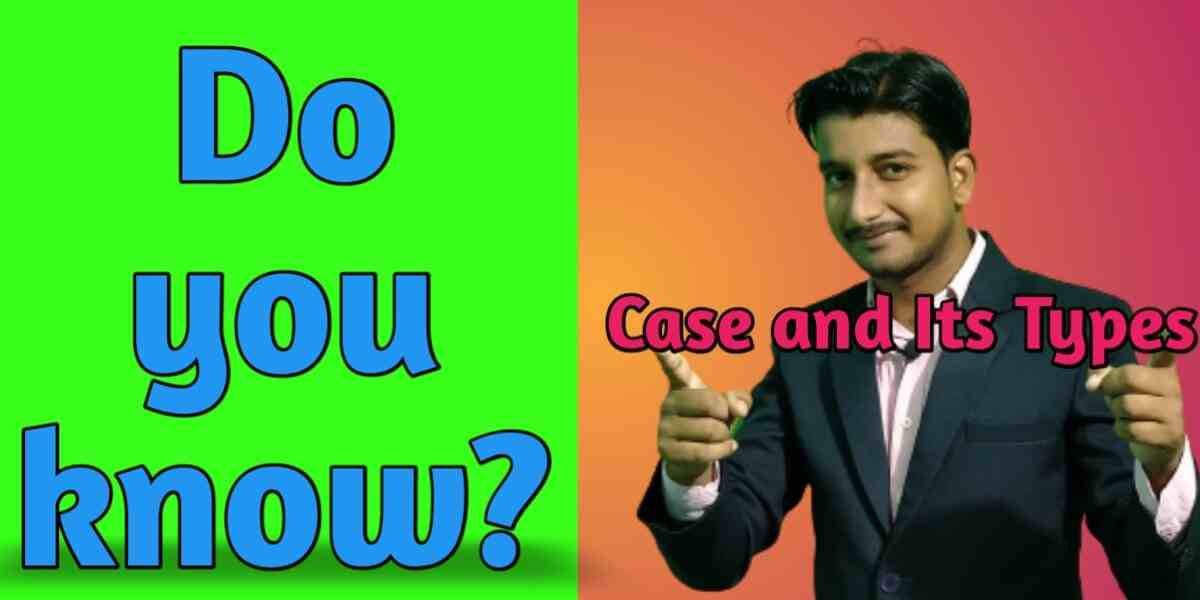In this article, we shall study Case in English Grammar with Its Types. The word which shows the relation of a noun or pronoun to some other words in a sentence is called case.
There are four types of Case in English Grammar
Table of Contents
- 1. Nominative Case (Subjective Case – कर्ता कारक )
- 2. Possessive Case (संबधकारक )
- 3. Objective Case (कर्म कारक )
- 4. Vocative Case (सम्बोधन कारक )
- Chart of Case
- Some Rules of Case in English Grammar
- Frequent Asked Questions (FAQs)
- How many types of cases are there in English grammar?
- 1. Nominative Case (Subjective Case - कर्ता कारक )
- 2. Possessive Case (संबधकारक )
- 3. Objective Case (कर्म कारक )
- 4. Vocative Case (सम्बोधन कारक )
- What is case and its example?
1. Nominative Case (Subjective Case – कर्ता कारक )
A noun or pronoun that acts as a subject of a verb is called Nominative Case.
Examples:
Shakespeare wrote many dramas in his time.
Golden Temple is famous in whole over the world.
Nitin wrote many letters for you.
इस sentence में Shakespeare, Golden Temple and Nitin, subject के रूप में work कर रहे हैं। इसीलिए , इन्हे Subjective Case कहा जाता है।
2. Possessive Case (संबधकारक )
The noun or pronoun which shows its relation or ownership on another noun is called possessive case.
This is Mayank’s father.
These are the windows of that room.
This is my pen.
ऊपर दिए गए examples में ‘s, of and my अधिकार दिखाने का काम कर हैं। इसीलिए, इन्हें Possessive Case कहा जाता है।
Note: Possessive Case में my , our , your , his ,her , its , and their का प्रयोग Noun के पहले नहीं किया जाता है।
Note 2: ‘s का प्रयोग हमेशा सजीव (Living object) के साथ जबकि of का प्रयोग निर्जीव (Non -living object) के साथ किया जाता है।
Examples: Mohan’s pen, Kamal’s fan, hen’s feed, the gate of school, the bottle of rohan etc.
3. Objective Case (कर्म कारक )
A noun or pronoun that acts as the object of a verb is called Objective Case.
Examples:
I helped you.
I play football.
She helped her.
You, football and her का प्रयोग object के रूप में हुआ है। अतः , ये objective case हैं।
Note: Objective Case का जगह हमेशा noun या pronoun ही लेता है।
4. Vocative Case (सम्बोधन कारक )
When a noun is called, it is known as vocative Case.
Examples:
Come here, Divyansh.
Are you going, brother?
Where is my sister?
ऊपर दिए गए examples में Divyansh, brother and sister का प्रयोग सिर्फ सम्बोधन के लिए हुआ है। अतः, ये Vocative Case हैं.
Chart of Case
Nominative Case Possessive Adjective Possessive Pronoun Objective Case I My Mine Me We Our Ours Us You Your Yours You He His Him She Her Hers Her It Its It Pankaj Pankaj's Pankaj They Their Theirs Them Who Whose Whom
Some Rules of Case in English Grammar
1.Singular Noun के साथ इस ‘s का प्रयोग किया जाता है।
Examples:
Cow – Cow’s
Shyam – Shyam’s
Rohan- Rohan’s
Tiger – Tiger’s
Crow- Crow’s
2.Plural Noun के साथ s’ का प्रयोग किया जाता है।
Cows – Cows’
Boys – Boys’
Girls- Girls’
Rohan- Rohan’s
Tiger – Tiger’s
Crow- Crow’s
3.कुछ Noun पहले से ही plural होते हैं उनके साथ apostrophe ‘s’ लगाया जाता है।
Examples:
children – Children’s
People – People’s
Men – Men’s
Women – Women’s
4.Compound Noun के last word के साथ apostrophe ’s/s’ का प्रयोग किया जाता है।
Examples:
Sister-in-law – Sister-in-law’s
Brother – in-law – Brother-in-law’s
Step-father – Step-father’s
5.जब दो Noun ‘and’ से जुड़े हो और दोनों के बीच में close relation हो तो आखिरी noun के साथ ही apostrope ‘s/s’ का प्रयोग किया जाता है। अन्यथा दोनों के साथ।
Examples:
Narendra Modi and Amit Shah’s loyalty is the true example of honesty.
Doctors’ and scientists’ contribution is sought to make our corona free.
पहले example में modi और shah के close relation की वजह से आखिरी term में apostrophe s का प्रयोग किया गया है जबकि दूसरे example में इसका उल्टा परिणाम है इस वजह से दोनों के साथ apostrophe s का प्रयोग किया गया है।
6.school, college, house, hospital, shop, clinic and church को बोध कराने के लिए apostrophe s का प्रयोग किया जाता है।
Examples:
St. Xavier’s school, doctor’s clinic, dentist’s hospital, educator’s house, etc.
7. Everybody, anybody, everyone, someone, no one, somebody, nobody, etc, जैसे Indefinite Pronoun के साथ apostrophe s का प्रयोग किया जाता है।
Examples:
Bunking the class is everybody’s problem.
Everybody’s attendance was missing today.
Virat Kohli follows nobody else’s but Mahendra Singh Dhoni.
8.Collective Noun के साथ apostrophe s और of दोनों का use किया जाता है।
Examples:
Police’s reaction
The reaction of people
cattle’s grass
the grass of cattle
9.Personified things (मानवीयकृत वस्तुएं ) के साथ ‘s प्रयोग किया जाता है।
Examples:
Nature’s law, Sorrow’s tears , Duty’s call , Nature’s beauty , Soul’s prayer , Death’s doer etc.
10..किसी भी country or place के नाम के पहले ‘s का प्रयोग किया जाता है।
Examples:
Sri Lanka’s history, India’s future, Bokaro’s water supply etc.
Note: Don’t use articles with Possessive Case.
Frequent Asked Questions (FAQs)
What is case and its example?
The word which shows the relation of a noun or pronoun to some other words in a sentence is called case.
There are four types of Cases.
1. Nominative Case or Subjective Case
2.Possessive Case
3.Objective Case
4.Vocative Case
Hope you all guys will like this dynamic topic, Case in English Grammar with Its Types
Read More…
Let’s be friends via Social Media:

3 thoughts on “Case in English Grammar with Its Types | Four Kinds of Case in Grammar”